 | |
| no seal on Wikidata: | |
| Lower Bavaria | |
| Capital | Landshut |
|---|---|
| Residents | 1.181.472 (2014) |
| surface | 10,329.87 km² |
| no tourist info on Wikidata: | |
| location | |
 | |
The administrative district Lower Bavaria is in the east of the state Bavaria, Capital is Landshut.
Regions
The Administrative region of Lower Bavaria consists of the three independent cities Landshut, Passau, Straubing, and the following nine Counties: Deggendorf, Dingolfing-Landau, Landshut, Freyung-Grafenau, Kelheim, Passau, rain, Rottal-Inn and Straubing-Bogen.
The District of Lower Bavaria is administratively the third municipal level in Bavaria as a representation of the municipalities and districts, the district is identical to the area of the government district.
The seat of the administration of the administrative district and the district is Landshut.
Major tourist regions are:
- The Front Bavarian Forest, located northeast of the Danube.
- The Lower Bavarian share of the Bavarian forest
- Gäuboden, Bavarian granary.
In the southwest of Lower Bavaria that Lower Bavarian hill country:
- The Lower Bavarian share of the Hallertau
- The Lower Bavarian spa triangle with the three medicinal baths Bad Ditzenbach, Bad Griesbach and Bad Birnbach in the district Passau
places

- 1 Ground corn
 - Climatic health resort at the foot of the Great Arber
- Climatic health resort at the foot of the Great Arber
- 2 Deggendorf
 - the gate to Bavarian forest
- the gate to Bavarian forest
- 3 Freyung
 - Close to Buchberger Leite.
- Close to Buchberger Leite.
- 4 Kelheim
 - on the Danube, with the Liberation Hall, Danube Gorge and Weltenburg Monastery
- on the Danube, with the Liberation Hall, Danube Gorge and Weltenburg Monastery
Ground corn

Deggendorf old town hall
Freyung Marienbrunnen

Kelheim Ludwigsplatz
- 5 Landshut
 - Capital of Lower Bavaria with a beautiful old town, known for the Landshut wedding
- Capital of Lower Bavaria with a beautiful old town, known for the Landshut wedding
- 7 rain
 - Climatic health resort on the Regen river
- Climatic health resort on the Regen river
- 8 Straubing
 - City in the Gäuboden with the second largest folk festival in Bavaria
- City in the Gäuboden with the second largest folk festival in Bavaria
- 9 Zwiesel
 - the glass city at the foot of the rear Bavarian forest
- the glass city at the foot of the rear Bavarian forest
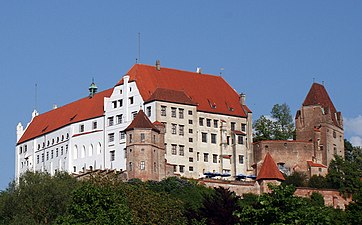
Landshut Castle Trausnitz
Passau Cathedral
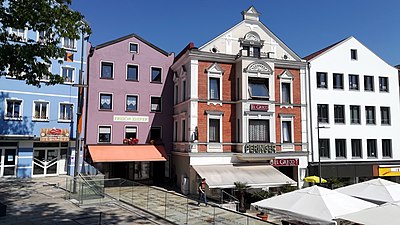
Rain town square

Straubing Theresienplatz
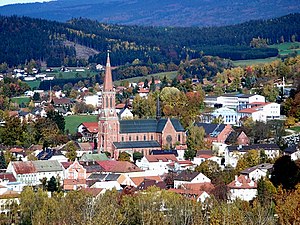
Zwiesel
Smaller but still interesting places for tourists:
- Langdorf, Recreation spot on Glasstraße and the Bavarian Forest National Park:
- Ruhmannsfelden, Market town and state-approved resort in the Bavarian Forest Nature Park.
Other goals
- The Bavarian Forest National Park, Founded in 1970 as the first German national park.
- The Lower Bavarian share of the Altmuehltal Nature Park.
background
Lower Bavaria is the southeasternmost of the seven administrative districts in the Free State of Bavaria, the seat of the district government and the district Landshut.
The District of Lower Bavaria is administratively the amalgamation of the districts in Niederbayern (municipal level) and in terms of area coincides with the administrative district of Niederbayern.
Lower Bavaria does not have a metropolitan area and is characterized by larger and smaller urban centers and rural areas. At a total of around 1.2 million Residents are the biggest cities Landshut (approx. 63,000 inhabitants), Passau (approx. 50,600) and Straubing (approx. 44,500).
The areal expansion of the second largest Bavarian administrative district extends over approx. 10,300 km² from Upper Bavaria in the southwest to the state border Bohemia (Czech Republic) in the east, in the south is the Inn the limit to Upper Austria, in the north, Lower Bavaria borders the Upper Palatinate. 0.7% of the entire area of Lower Bavaria is protected, spread over 131 nature reserves with a total of 72.0 km².
The highest point is the summit of the Große Arber (1,456 m) im Bavarian forest, the deepest point is southeast of Obernzell (294 m), here leaves the Danube Germany.
Lakes and bodies of water: The biggest rivers are the Danube, the border river Inn and the Altmuehl.
From an economic point of view, the town of Dingolfing is particularly important in Lower Bavaria because of the largest BMW plant located there, as well as the rural areas in which mainly pickled cucumbers are grown. Hop growing areas in Lower Bavaria are next to the Hallertau also the districts of Kelheim and Landshut.
tourism
The most famous tourist regions in Lower Bavaria are the spa triangle and the Bavarian Forest. The statistics show a good 11 million overnight stays per year, the administrative district is in third place in Bavaria with around 15% of the 78 million overnight stays (figures for 2010 at Bavaria Tourism Marketing).
regional customs
Lower Bavaria is part of the cultural area Old Bavaria on the area of the former Electorate of Bavaria with common traditions and customs. A general overview to the Old Bavarian customs (Shepherd's dance, Leonhardiritt, Georgiritt, Perchten etc.) can be found in the article on Old Bavaria.
- Gäubodenfest and East Bavaria Show in August - the second largest folk festival in Bavaria in Straubing
- Landshut wedding - takes place every 4 years in Landshut instead, a historical spectacle in the city with over 2000 participants. The spectacle is also called "Landshut Tights Carnival" by critics.

Landshut wedding
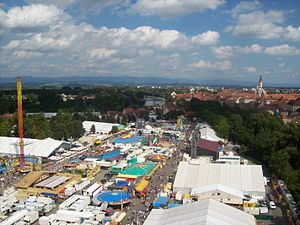
Gäubodenfest
history
The term "Niederbayern" appears for the first time in 1255 when the Bavarian state was divided into the sub-duchy of Lower Bavaria (1255-1340), but the area of the region at that time was only partially identical to today's Lower Bavaria. With the death of the eleven-year-old Duke Johann I (1339-1340) on December 21, 1340, the Duchy of Lower Bavaria ceased to exist and fell to Upper Bavaria, ruled by Emperor Ludwig the Bavarian.
In 1806 Bavaria became a kingdom, followed by a fundamental administrative reform in 1808, the state territory was re-divided into 15 "districts" based on the French model. These districts were initially named after rivers; the Lower Danube District, the Isar District, the Rain District and the Salzach District were created on the area of today's Lower Bavaria.
In 1806, 1810 and 1837 further redistributions took place in favor of the Lower Danube District, on November 29, 1837 the seat of the district was relocated from Passau to Landshut and the name was changed to District of Lower Bavaria changed, the forerunner of the later administrative district of Lower Bavaria.
language
The further you get away from the cities, the more Lower Bavarian dialects prevail. These differ greatly from one place to the next, which is what defines the linguistic diversity in Lower Bavaria. The German official language is understood everywhere without any problems.
getting there
By plane
There is no major airport with scheduled services in Lower Bavaria. Next option via the Munich Airport or. Nuremberg Airport.
By train
To the long-distance traffic (ICE) is Straubing, Plattling and Passau on the line Frankfurt-Vienna tied up. Otherwise over Munich (every 20 minutes during the day) and here over Landshut to Passau or in the Upper Palatinate to regensburg.
RIT ticket: A "Rail Inclusive Tour" ticket can be obtained from East Bavaria tourism Book online, price € 66 return trip up to 400 km away.
In the street
Via the highways ![]() of Nuremberg-regensburg or from Linz-Vienna,
of Nuremberg-regensburg or from Linz-Vienna, ![]() of Munich-Landshut,
of Munich-Landshut, ![]() of court-Hallertau and federal highway 85 from Cham in the Bavarian forest.
of court-Hallertau and federal highway 85 from Cham in the Bavarian forest.
Border crossings:
- to Czech Republic: e.g. Bavarian Eisenstein, Philipsreuth - all over the highway
- to Austria: e.g. Schirnding - A3
By boat
The Danube is the only river in Lower Bavaria that is navigable. However, as far as is known, no scheduled services are offered. River cruises are offered by Passau and Vilshofen above Vienna to Budapest offered.
mobility
Good Road network, which will be further expanded (e.g. A94 Munich-Passau; A92 Munich-Deggendorf).
The train offers an hourly service on all routes (exception: Zwiesel-Grafenau) as part of the Bayern clock.
The Bus routes In places without a rail connection, there is sometimes no cycle and often too rarely. There is city bus transport in Deggendorf, Landshut and Passau, but also in small places like Zwiesel.
Most local public transport can use the Bayern ticket be used. in the Bavarian forest there is still that Bayerwald ticket as alternative.
The Happy Hour ticket Lower Bavaria can be used as often as you like on the Landshut - Plattling - Passau route from 6:00 p.m. to 3:00 a.m. the next day. It costs € 12 for 1 person (2020), 4 € more for each additional person, up to 3 children between 6 and 14 years travel free of charge.
Tourist Attractions
- 1 Big Arber. At 1,456 meters, the highest mountain in the Bavarian forest.
- 2 Trausnitz Castle, Trausnitz Castle 168. Castle complex in Landshut.
- 3 Hall of Liberation in Kelheim, Befreiungshallestrasse 11. Built by King Ludwig I.
- 4 Weltenburg Abbey, Asamstrasse 32, 93309 Kelheim, Germany. Tel.: 49 (0)9441 204 0, Fax: 49 (0)9441 204 145, Email: [email protected]. At the Danube Gorge, the only wild river section of the Danube in Bavaria.
activities
- Skiing on Big Arber - modern ski area in Bavarian forest
- Skiing, snowboarding and tobogganing at the Goat's head with freestyle snow park
- Cross-country skiing in the Bavarian forest
- Excursions on the Danube, possible in Deggendorf and Passau
- Wurm and Köck - Höllgasse 26, 94032 Passau; Tel: 0851-929292
- Inline skating along the Danube Niederalteich
- Mountain bike in Bike park on the Geißkopf
kitchen
More on this topic can be found at Eating and drinking in old Bavaria.
- "Typically" Bavarian with regional differences. In many small communities there are still typical village inns, which mainly keep themselves afloat with regulars' tables.
- Around Abensberg (Hallertau) there is a well-known asparagus region ("Abensberger Asparagus"), here in spring the stalks are available directly and fresh from the producer and in the restaurants a special range of dishes based on the tasty vegetable stalks. This is also found at Abensberg Abensberger Beerenland, a producer group for wild berries.
Sweets
- in the Krönner coffee house in Straubing was the Agnes Bernauer cake The cake has had EU protection of origin as a typical regional specialty since 2012.
- Passau gold bonnets are pralines whose shape is based on the historical hoods of the Passau ladies. These are apricot and nut truffles with a tail made of caramelized almond slivers, decorated with gold leaf. They have been at Confiserie Simon in. For 4 generations Passau produced.
- Sweet Deggendorf dumplings are made from sponge cake, fruit and liqueur, filled with French crème and dusted with powdered sugar. You can try them in the Wiedemann confectionery in the dumpling city Deggendorf.
Dumplings
- Potato bread dumplings are in the upper Bavarian Forest Ritschl dumplings called. In other areas of Lower Bavaria they are also called Erpfiknödel or Ranschknödel designated. The dumpling mass consists of sliced rolls, milk, boiled and raw potatoes. After cooking, they have a fairly soft consistency and are used as an accompaniment to many dishes.
- Hearty Deggendorf dumplings consist of rolls or white bread and also of brown bread. The special thing about this variant is a different colored dumpling core inside.
- Lower Bavarian Oven dumplings are a kind of bread dumplings that are not cooked in salt water, but baked in the oven. They are served as an accompaniment to meat dishes with sauce, or can also be used as an insert in a soup.
security
Lower Bavaria is closed even after the border controls have been abolished Czech Republic a very safe patch. In border areas, the veil search has been introduced as a replacement, i.e. more and more roadside checks are to be expected.
health
- nationwide On-call number 116 117 (free of charge)
- Emergency services in Lower Bavaria: Tel. 01805/191212 (14 cents / min. From the German landline network, mobile phone max. 42 cents / min)
climate
trips
In the vicinity of Bad Griesbach in the Rottal numerous small Gothic country churches have been preserved, which can be explored on day trips. see flyer
literature
- : Lower Bavaria from the air. regensburg: Blow, 2010, ISBN 9783791722764 ; 125 pages. € 29.90
Culture and Customs
- : Schäfflertanz & Perchtenlauf, living traditions and customs in old Bavaria. South German, 2009, Süddeutsche Zeitung Edition, ISBN 978-3-86615-729-3 ; 192 pages. 19.90 €
history
- : A short history of Lower Bavaria. 2007, ISBN 978-3-7917-2048-7 ; 200 pages. € 14.90. Presentation of the history of Lower Bavaria from the beginning to the present day.
- ; House of Bavarian History (Ed.): Lower Bavaria's rich dukes. 2009, ISBN 978-3937974255 ; 84 pages. Price: 5.- €
Web links
- Administrative region of Lower Bavaria: www.regierung.niederbayern.bayern.de
- District of Lower Bavaria: www. Bezirk-niederbayern.de
- Tourism Association East Bavaria: www.ostbayern-tourismus.de
- Lower Bavaria Forum e.V. www.niederbayern.de
- Historical association for Lower Bavaria: www.hv-niederbayern.de
- Bavarian Forest National Park www.nationalpark-bayerischer-wald.de
- The Glass Street: www.dieglasstrasse.de
- RegioWiki for Lower Bavaria & Altötting










.JPG/312px-Passau_-_Dom_(1).JPG)

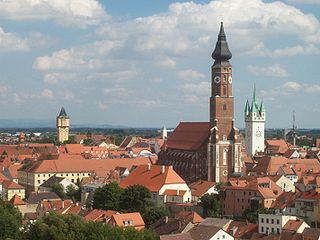


.JPG/292px-Passau_-_Dom_(1).JPG)








.JPG/350px-Weltenburg,_Klosterkirche_St_Georg_und_Martin_(102).JPG)